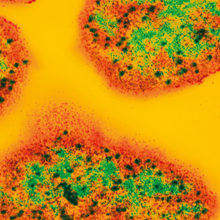Editorial
Issue: Archaea
08 August 2017 article

Welcome to the August edition of Microbiology Today, and one in which we consider the role of archaea and their impact on microbiology since their reclassification in the 1970s. The Archaea are a fascinating set of microbes that can thrive in unusual environments, including some of the most extreme places on the planet. They can survive in extremes of temperature, pH and pressure, and are found in many places including the deep sea, volcanoes and within the guts of animals and humans.
Archaea have historically been given a back seat in terms of research and publicity, perhaps because of the generally accepted premise that there are no archaeal pathogens, and so much of the research has focused on their involvement in methane and ammonia cycling. There are also difficulties associated in culturing these microbes in the lab, and as culture- independent techniques improve, research evolves and more information about these microbes emerges. Archaea have significant roles in aspects of global ecology, and the collection of articles in this edition highlights how widespread and successful these organisms are.
Our first piece, written by Graeme Nicol, gives an insight into the role of archaea in the nitrogen cycle. The presence of large numbers of ammonia- oxidising archaea in oceans and soils has shifted global understanding of how nitrification works. Graeme discusses how the application of fertiliser during the 20th century has led to an accelerated nitrogen cycle, causing damage to the environment. He then outlines how ammonia-oxidising archaea could be utilised to alleviate some of these pollution problems.
The second article has been contributed by Marta Filipa Simões and André Antunes, and provides details of the role of archaea in the activated sludge process. This essential treatment of wastewater is relatively affordable and produces high-quality effluent. The activated sludge is known to contain a majority of bacteria, and the role of archaea, integral within the process, is still incompletely understood. There is evidence that methanogens and ammonia-oxidising archaea contribute to the activated sludge in a fundamental way, and there is a growing recognition that more work is needed to understand the diversity and function of archaea within activated sludge.
In our third piece, Daniela Barillà explains the importance of genome segregation in archaea that thrive in temperatures of over 80 °C. Building on work from archaeal pioneer Wolfram Zillig, researchers are now discovering new information on the roles of both chromosome segregation and three-component plasmid segregation machinery, relevant to all life on Earth.
Laura Eme and Thijs Ettema pose the question of archaeal involvement in eukaryotic evolution. Did chloroplasts and mitochondria arise from endosymbiosis between plants, cyanobacteria and alphaproteobacteria? Or did fusion between an archaeon and an alphaproteobacterium lead to eukaryotic cells? The availability of sequence data has revealed a surprising deep-sea link to eukaryotic origins.
CRISPR-Cas adaptive immune systems have been the focus of much scientific and media attention recently. In this article, Qunxin She and Wenyuan Han explain how these systems are unevenly distributed amongst bacteria, possibly due to the presence and pressure from archaeal viruses driving the selection of one or more CRISPR-Cas within archaea. They also discuss how Cas accessory proteins might modulate the functionality within CRISPR-Cas systems.
James Chong writes the Comment piece, highlighting the hazards (including explosions) that can be associated with working with archaea. He ponders why there are no archaeal pathogens, and the answer suggests there may be many complexities at play. Evidence proposes that archaea could be functioning as opportunistic pathogens in a range of health conditions. As in so many microbiological studies, the analytical methods employed may have, until recently, given a skewed picture. Improved techniques could lead to new questions about the status of these microbes.
Rowena Jenkins
Editor
[email protected]
Image: Cold-loving archaea. Coloured transmission electron micrograph of a section through the archaeon Methanococcoides burtonii. The cell walls appear red, while the granular cell contents include scattered genetic material. These psychrophilic (cold-loving) archaea were discovered in 1992 in Ace Lake, Antarctica, and can survive in temperatures as low as –2.5 ºC. As methanogenic microbes, they are able to form methane from carbon dioxide and hydrogen. Dr M. Rohde, GBF/Science Photo Library.


